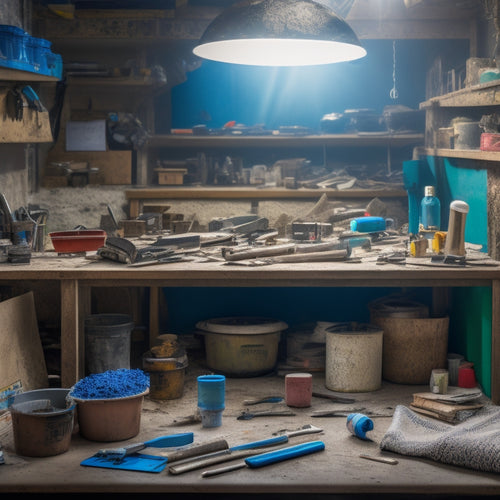
3 Tools to Budget for Home Renovation Success
Share
You'll need to budget for three critical categories of tools to guarantee a successful home renovation: equipment costs, essential tools for specific tasks like cinder block work, and material expenses that can quickly spiral out of control. Accurately estimating tool costs is vital, considering rental fees, purchase prices, and labor costs for specialized equipment. You'll need to identify necessary tools like levels, trowels, and mixers, and factor in material expenses, which typically represent the largest portion of renovation budgets. By accounting for these key expenses, you'll be better equipped to manage your budget and avoid costly surprises that can derail your project.
Key Takeaways
• Accurately estimate tool costs by considering rental fees, purchase prices, and labor costs for specialized equipment to avoid financial stress.
• Identify necessary tools for each task and research their costs to create a comprehensive budget.
• Renting infrequently used tools can be more cost-effective than purchasing, while factoring in tool depreciation for frequently used tools.
• Budget for material expenses, which typically represent the largest portion of renovation budgets, and account for price fluctuations.
• Create a contingency fund to cover unexpected material price increases and regularly track costs to maintain budget accuracy.
Estimating Tool Costs Accurately
To avoid blowing your budget, you'll need to estimate tool costs accurately, considering factors like rental fees, purchase prices, and labor costs for specialized equipment.
Inaccurate cost estimation can lead to financial stress and project delays.
Start by identifying the tools you'll need for each task, and then research their costs.
Consider renting tools that you'll only use once or twice, as this can be more cost-effective than buying.
For tools you'll use frequently, calculate the cost of purchase and factor in tool depreciation.
Depreciation can notably impact your overall cost, so be sure to account for it.
Create a thorough list of all the tools you'll need, along with their estimated costs, to get a clear picture of your total expenditure.
Essential Tools for Cinder Block
You'll likely need a mix of handheld and power tools to successfully work with cinder blocks, including a level, trowel, and mixer. When working with cinder blocks, it's crucial to have the right tools to guarantee the job gets done efficiently and effectively.
Here are some important tools you'll need:
-
Level: Verify your blocks are perfectly aligned and level to prevent structural issues.
-
Trowel: A must-have for applying and shaping mortar between blocks.
-
Mixer: Mix and blend cement, sand, and water to create the perfect mortar.
- Safety gear: Don't forget to protect yourself with gloves, safety glasses, and a dust mask when working with cinder blocks.
When choosing cinder block types, consider factors like weight, texture, and color to match your construction techniques. From concrete blocks to insulated blocks, each type has its unique benefits and uses.
Budgeting for Material Expenses
Budgeting for Material Expenses
Your material expenses will likely be the largest chunk of your home renovation budget, so it's essential to accurately estimate and track these costs to avoid financial setbacks.
To do this, you'll need to research and account for material price fluctuations, which can be unpredictable. One effective budgeting technique is to create a contingency fund to cover unexpected price increases.
Here's a breakdown of how to allocate your material expenses:
| Material Category | Estimated Cost |
|---|---|
| Cabinets and Countertops | 30% of total budget |
| Flooring and Lighting | 20% of total budget |
| Paint and Drywall | 10% of total budget |
Frequently Asked Questions
How Do I Prioritize Renovation Tasks to Maximize My Budget?
You'll need to prioritize renovation tasks strategically to maximize your budget.
Start by conducting a task assessment, identifying must-haves, nice-to-haves, and cosmetic changes.
Then, allocate your budget accordingly, focusing on essential tasks that impact functionality and safety.
Consider phasing non-essential tasks to free up funds for future projects.
Can I DIY or Should I Hire a Professional for Certain Tasks?
You're weighing the pros and cons of DIY vs. hiring a pro for certain tasks.
Consider the DIY benefits: saving money, learning new skills, and having control.
However, don't underestimate the value of professional expertise. They'll bring efficiency, quality, and safety to complex or high-stakes tasks.
Be honest about your skills and available time. If you're unsure, it's better to hire a pro to avoid costly mistakes and guarantee a stress-free renovation.
What Percentage of My Budget Should Go to Contingencies?
When allocating your budget, you'll want to set aside a chunk for contingencies.
Aim to dedicate 10-20% of your total budget to contingency planning. This will give you a cushion for unexpected expenses that inevitably arise during renovations.
By prioritizing budget allocation, you'll avoid financial stress and guarantee your project stays on track.
This proactive approach will empower you to tackle unexpected setbacks with confidence.
How Do I Negotiate With Contractors to Get the Best Price?
When negotiating with contractors, you'll want to focus on effective contractor communication and savvy pricing strategies.
Start by researching the going rate for your project, then ask contractors to break down their quotes into detailed line items. This will give you leverage to discuss specific costs and identify areas for negotiation.
Be transparent about your budget, and don't be afraid to walk away if the price isn't right.
What Are Some Common Renovation Surprises That Can Blow My Budget?
When renovating, you'll likely encounter surprises that can blow your budget. Be prepared for hidden costs like asbestos removal or foundation repairs, which can add up quickly.
Unexpected delays, such as weather-related setbacks or material shortages, can also derail your timeline and increase expenses.
You'll need to pad your budget to account for these surprises, so plan ahead and prioritize flexibility to minimize the financial impact.
Conclusion
As you near the finish line of your home renovation journey, remember that budgeting is the map that guides you through the twists and turns.
Without it, you're lost in a labyrinth of expenses, struggling to find your way back to financial stability.
But with these three tools, you'll navigate the process with ease, emerging on the other side with a beautifully renovated home and a budget that's still intact.
Related Posts
-

Why Do Cinder Block Wall Renovations Cost So Much
You're likely surprised by the high cost estimate for your cinder block wall renovation project, but it's driven by s...
-

3 Best Planter Shopping Timeline Tips for Renovators
When incorporating planters into your renovation project, you'll want to plan carefully to avoid delays and guarantee...
-

Get Discounted Plastering Tool Sets for DIY Renovations
You can find discounted plastering tool sets online, at local hardware stores, and thrift stores, offering a range of...


